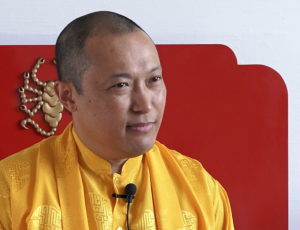Saturday
Dharma TeachingsWarriorship in the World
 The Shambhala vision speaks of the inherent goodness and the innate wakefulness of human beings. The Shambhala teachings and our practices have the intention and power to open the door to compassionate care for ourselves and others. Our tagline is “Making Enlightened Society Possible.” That’s a tall order, and what does it really mean anyway? What would it look like in reality to have an enlightened society? One of the explanations that I find simple and workable is that it is not a utopia where aggression, doubt, and ignorance never occur. Instead, it is a culture in which life’s challenges are met with kindness, generosity, and courage. The citizens of enlightened societies would have a deep sense of confidence in themselves and others, and their actions would reflect this. So this isn’t just a Shambhala thing or a Buddhist thing – it is a human thing. All of us, no matter what our politics, religion, sexual orientation, or gender identity are capable of creating an awake society.
The Shambhala vision speaks of the inherent goodness and the innate wakefulness of human beings. The Shambhala teachings and our practices have the intention and power to open the door to compassionate care for ourselves and others. Our tagline is “Making Enlightened Society Possible.” That’s a tall order, and what does it really mean anyway? What would it look like in reality to have an enlightened society? One of the explanations that I find simple and workable is that it is not a utopia where aggression, doubt, and ignorance never occur. Instead, it is a culture in which life’s challenges are met with kindness, generosity, and courage. The citizens of enlightened societies would have a deep sense of confidence in themselves and others, and their actions would reflect this. So this isn’t just a Shambhala thing or a Buddhist thing – it is a human thing. All of us, no matter what our politics, religion, sexual orientation, or gender identity are capable of creating an awake society.
The word enlightenment in Tibetan is changchup, which means purifying negative aspects or obstacles. We purify the thickness in our mind and our perceptions, and develop the mind of enlightenment. This is not something that happens quickly. It is a process that takes time, and in fact it can take a lifetime or more. The meaning of purify or purification as it is used here is not synonymous with the western meaning of cleaning the unclean. It’s more a sense of developing our minds further, so we can see with our wisdom eye what is actually going on rather than what we think is going on. Sort of like the transformation of coal into a diamond. We are developing our minds so they are no longer obscured by our habitual patterns, which could very well be based on fear, doubt, and ignorance.
How do we perceive our world? This is a huge question that arguably has been around since humanity began. What is our own personal belief about the nature of humanity? How we view our world and the other sentient beings in it absolutely affects our actions. It’s naïve to think it doesn’t. When was the last time you actually took the time to contemplate who you are, and to see what you think about yourself and the world? I think this contemplation is as important, in a big picture sense of things, as eating and sleeping. I’m convinced that shamatha meditation is the best way to begin this journey of waking up.
Here’s a quote from Sakyong Mipham Rinpoche, in a talk he gave in 1999:
“If we are going to learn something, absorb something, or recognize something, we need the ability to be present. That part of our mind has to be right there before we can know whether something is rough, soft, loud, quiet. In shamatha (calm or peaceful abiding) practice, we are learning to extend this very rudimentary element of our mind. What we discover is that this basic mindfulness isn’t very steady; it’s hard to prolong. Shamatha is a way to train that basic aspect of mind. The original texts that talk about shamatha come from a meditative tradition that existed in India prior to the time of the Buddha; shamatha, and especially the nine stages of training the mind, were quite common. These teachings were incorporated into Buddhism because it was understood that if you wanted to train the mind, if you wanted to stabilize the mind, you needed to do this practice.”
So it’s been said that the shamatha meditation technique is the ground on which any path of study or practice begins. In other words, shamatha stabilizes our mindfulness and awareness so we can remain in the present moment. If we are lost in thoughts of past or future, or if we can not stay focused enough to listen to our partner sharing about his day, or listen to the doctor telling us what our aging mother is going to need, then we will not be able to be of full benefit to anyone. We will only get bits and pieces of reality, and will endlessly be spinning our wheels trying to catch up and wondering how we got to where we are.
Our body, speech and mind are how we show up in our world. We are doing something, saying something, or thinking something. Thinking of these three as gates, or doorways, between us and our world is a great reminder to pay better attention to how we use our body, how we use our speech, and how we use our mind. It matters. What is motivating our actions at any given time? What was our motivation for saying to our friend, “I really miss you and would like to get together.” What was our motivation for shaking our head and rolling our eyes when our co-worker said something we disagreed with? You get my point here – everything does matter. Not necessarily in some huge cosmic way, but every action still matters, so we could pay better attention to our behavior. I like this short definition of motivation: Motivation is the reason for people’s actions, desires, and needs.
I’ll end with some words from Chogyam Trungpa about the Tibetan meaning of warriorship:
“Warriorship refers to realizing the power, dignity, and wakefulness that is inherent in all of us as human beings. It is awakening our basic human confidence which allows us to cheer up, develop a sense of vision, and succeed in what we are doing. Because warriorship is innate in human beings, the way to become a warrior – or the warrior’s path – is to see who and what we are as human beings and cultivate that. If we look at ourselves directly, without hesitation or embarrassment, we find that we have a lot of strength and a lot of resources available constantly. From that point of view, if we feel we are without resources, if we feel incompetent or as if we were running out of ideas, it is said that we are being attacked by the enemy of warriorship: our own cowardice. The idea of warriorship is that because of our human potential we can go beyond that, step over the enemy of cowardly mind, and discover further banks of resources and inspiration within ourselves. Becoming a warrior means that we can look directly at ourselves, see the nature of our cowardly mind, and step out of it. We can trade our small-minded struggle for security for a much larger vision, one of fearlessness, openness, and genuine heroism. This doesn’t happen all at once but is a gradual process.”
“The confident warrior conducts himself with gentleness, fearlessness, and intelligence. Gentleness is the warm quality of the human heart. Because of the warmth of his heart, the warrior’s confidence is not too hard or brittle. Rather it has a vulnerable, open and soft quality. It is our gentleness that allows us to feel warmth and kindness and to fall in love. But at the same time we are not completely tender. We are tough as well as soft. We are fearless as well as gentle. The warrior meets the world with a slight sense of detachment, a sense of distance and precision. This aspect of confidence is the natural instinct of fearlessness, which allows the warrior to meet challenges without losing her integrity. Finally, our confidence expresses itself as innate intelligence, which raises ordinary gentleness and fearlessness to the level of warriorship. In other words, it is intelligence that prevents gentleness from becoming cheap romanticism without any vision, and fearlessness from becoming purely macho.”
Good luck warriors. The world needs ALL of us to wake up. That includes you and me.
Susan Firer is a co-founder of Windhorse Retreat Center. This piece originally appeared on the Center’s blog page, at https://windhorse.shambhala.org/blog .





